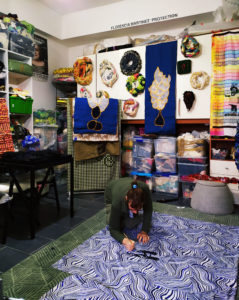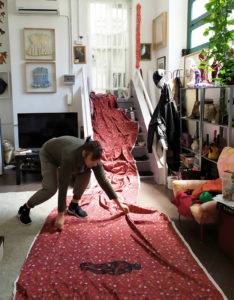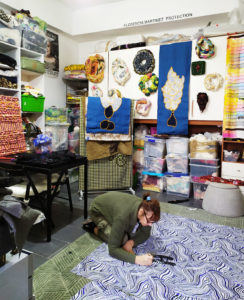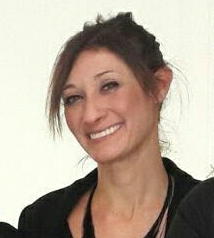Florencia Martinez, Italian-Argentine artist, born in 1962. Treated by Gilda Contemporary Art in Milan, Zaion Gallery in Biella and Galleria Stefano Forni in Bologna, she recently participated in the 18th Biennial of Bangladesh and at the exhibition in Shenzhen at the Easyway Century Fashion Museum in collaboration with the Chinese stylist Hui Zhou Zhao with the curatorship of Barbara Santoni. She participated at an artist residence at the Marca di Catanzaro with the Rocco Guglielmo Foundation where she developed in an action-performance that part of her work that brings her closer to the people, both to their work than to the most unspeakable feelings, and in the MACRO in Rome in the “Atelier” project with the installation “The southern seas”, a reflection on today’s Italy connected with that of the post-war period. Her themes investigate the role of women, family dynamics, the historical memory of places and the social footprint in the construction of identity.
E.L. For some time you have left the studio space to work entirely from home. What has changed?
F.M. Since 2006 I have worked in the studio, in a place that has remained the same for years, in Piazza Prealpi, in Milan. Having chosen a material such as fabric, which is basically portable, I could also work from home. For years I have produced a lot. I worked both in the studio and at home, but I wasted a lot of time going back to take from home some materials I needed in the studio, and vice versa. So two years ago I decided to combine home and studio. In this choice, I lost some work space but gained time and speed in finding the pieces I need even if today I am still a bit “lost” in this new organization …
E.L. Are you lost because you feel that the home is not your ideal environment to produce?
F.M. Home is an environment that I feel is perfect for my type of work, much more than a studio. The material I use is homely, everyday, and in a house it finds its ideal environment because it refers to a housework: the house echoes me while I work. Here I feel that my work is more true, real. I haven’t fully settled in yet because I haven’t had the time yet: since I left the studio it has been a succession of exhibitions, the trip to China, the residency at the Marca, the exhibition in Crete at fortress of Rethymno, and then family dynamics that were intertwined with work dynamics prevented me from concentrating entirely on work.
E.L. How is your working method? Do you dedicate fixed hours to work, do you have your own “discipline” or not?
F.M. I don’t have a discipline in the sense that I always work, continuously. When I start a new job I never know what I’m doing, I only realize it later. It is a bit like when it starts to rain: first you feel a drop, then the other and you understand that the rain, the storm is coming! I would call my way of working a “waterspout method”: a torrent in flood. I always work. When I do nothing else, the daily things, I work. My impatience now is precisely the fact that you don’t have a totally dedicated large enough space. I don’t waste time going from home to the studio to recover missing materials, but the difference compared to now is that in the studio I could dedicate myself entirely to the depth of the work, in concentration. In the studio I sewed for six hours straight, even in difficult conditions, with very little light, always with electric light. But they were concentrated hours. When I left the studio I was stunned, I went out into another world, like a comics. Work at home, on the other hand, interferes with daily life. As the journalist Lisa Corva says, the call of the washing machine is heard at home! (she laughs)
E.L. Working at home, do you manage to contain your work or does your work invade the space of everyday life? Do you have works exhibited everywhere, unfinished projects scattered in every corner of the house?
F.M. I use the whole house as a studio even if we say I am no longer a fun-loving mess, I can no longer sprout my ancestral disorder everywhere. I miss that part now, the catharsis, the getting lost. It was time for me to become more reasonable perhaps. In the studio if the glue fell on the ground I could leave everything like this, at home not … guys cannot grow up with needles on the ground! (she laughs). I try to keep order, I organize the fabrics in the boxes, but when I am in full swing the abundance of disorder overcomes all good will. The work invades the house. The house is my studio and my store at the same time.
E.L. Since you no longer work in the studio, how are you changing your works in terms of size?
F.M. Before I processed several large pieces simultaneously: the Pietà exhibited by Gilda, or the chair you saw at the Zaion Gallery. Now I can only work one large sculpture at a time. In this period I am working on a series of “Hugs” that will be present in December by Gilda Contemporary Art. The hugs were born in this period of lockdown, in which it was not possible to see or even hug each other. They are small sculptures, daughters of the small works exhibited in Triennale in 2018 for the “Materially” project by Angelo Crespi and Alessandra Redaelli.
E.L. Speaking of materials, what kind of fabrics do you use?
F.M. Above all recycled fabric: I want to make a song out of the more modest fabric. For me, the fabric is something alive, a popular material to which I apply the stitching, the knot, the reinforcement, which are very evident because the manipulation I make of it, the processing and the layering must be evident. It brought back to life different fabrics: most of them have been given to me over the years, such as these laces donated by a Greek house of wedding dresses, or the remnants of the Argenti silk factory in Como. The fabric in this way already has its own life, a past, which is intertwined with my present and is stratified. I buy new fabrics only when I look for a particular material, such as the blue jute used for the exhibition “H” by the Gilda Contemporary Art curated by Alessandra Redaelli. In that case, for example, I needed a deep and at the same time rough blue, I wanted to unite the sacred and the profane starting from the colored jute material.



For all the images: Florencia Martinez studio. Ph credits: Alessandra Palumbo
E.L. Despite the difficulties in managing work at home, you told me that the Covid-19 experience brought you closer to art, to the desire to do.
F.M. A little before the virus I spent months thinking about what sense contemporary art in general now has. I felt a feeling of uselessness, of repetition, of boredom, of things already seen. Then I was stuck at home in this film situation … This forced cage brought me closer to doing. Despite the tight spaces, being at home-studio allowed me to devote myself to work in this period, to reconnect with what I have always been: a humble artisan artist.
E.L. What projects did you work on during the quarantine period and what are your plans for the future?
F.M. I started working again with the project “The breath of art” by Virginia Monteverde, a project in which a group of Italian and international artists reinterpreted the mask, a symbol of protection and struggle at the same time. Simultaneously with that, I started developing Abbracci and a strange research on fabric and material for the end of year exhibition at Gilda. I would like to make 100 of them, in order to create a large installation of isolated figures that tell about this period. I also finished 170 designs on fabric for the Bau magazine in Viareggio. The future? Will arrive!
Info:

Erika Lacava, degree in Aesthetic Philosophy at the State University in Milan with a specialization in Visual cultures and curatorial practices at the Brera Academy. From 2014 to 2017 with the experience of Zoia – Contemporary Art Gallery she comes into direct contact with the dynamics of scouting and the art market. Independent curator, collaborator for printed and online art magazines, in 2019 she founded the communication and services start-up for art M2F Communication.






NO COMMENT